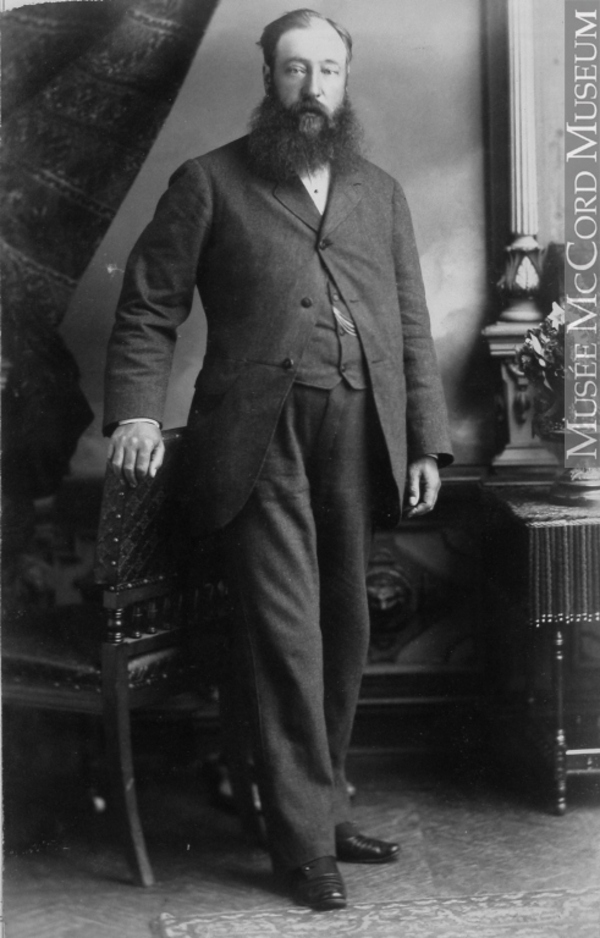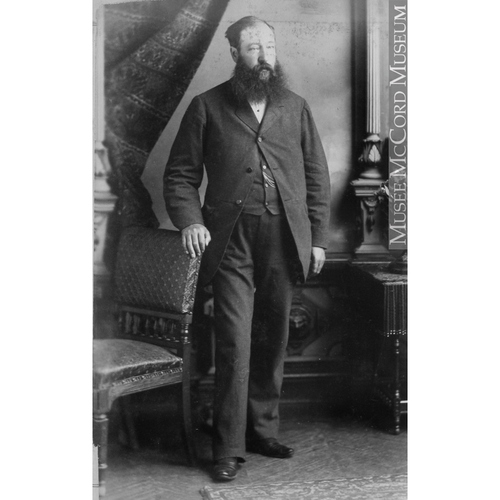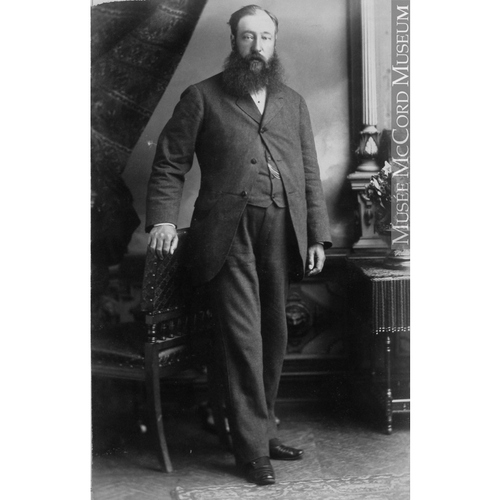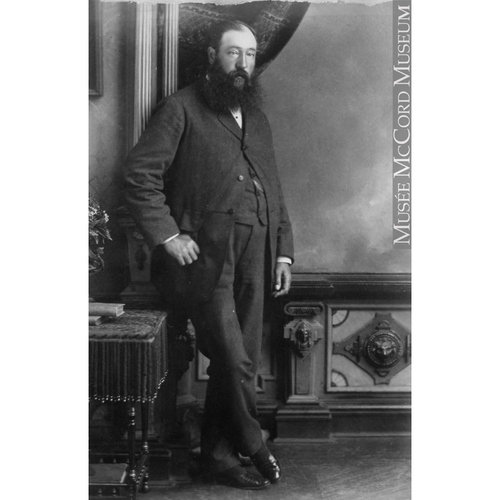
Source: Link
BANNATYNE, ANDREW GRAHAM BALLENDEN (baptized Andrew Grahme Balenden), merchant and politician; b. 31 Oct. 1829 on South Ronaldsay, Orkney Islands, son of James Bannatyne and Eliza Balenden; m. in 1851 Annie, daughter of Andrew McDermot; d. 18 May 1889 at St Paul, Minn.
Andrew Graham Ballenden Bannatyne was only three when his father, a British government fishery officer stationed at Stromness, Scotland, died. During his school years there, Andrew was deeply influenced by the family connection with the Hudson’s Bay Company, in which both a grandfather and a great-grandfather had served. At 14, after completing “high school,” Bannatyne entered the service of the HBC as an apprentice clerk, and was sent to Sault Ste Marie (Ont.) for two years, and then to Red River (Man.).
Bannatyne soon became keenly aware of the commercial possibilities at Red River and determined to leave the HBC when his contract expired on 1 June 1851. He set up as a general dry goods merchant and fur-trader and was immediately successful despite the prediction of the governor of Rupert’s Land, Eden Colvile*, that “this youth will [not] be a very formidable opponent.” His parting with the HBC was not amicable. Bannatyne later indicated to an acquaintance: “I am still in their black books. I wish the whole of them were now in McKenzie’s River living on nothing but Jack Fish.”
The 1850s were not an easy time for the HBC whose control over the civil government of Assiniboia and monopoly of the fur trade were being effectively broken, first by the events which culminated in the trial of Pierre-Guillaume Sayer* in 1849 [see Adam Thom], and increasingly by free traders such as Bannatyne and his father-in-law, Andrew McDermot. The company made a final attempt to protect its position in 1858 when George Barnston arrested Bannatyne at Norway House (Man.). But the HBC legal advisers decided his arrest had been illegal, and Bannatyne was quickly released and compensated by the company. All hope for the resurrection of its monopoly was destroyed. Bannatyne went on to great business success. In 1868 he formed a partnership with Alexander Begg* and their spring brigade that year consisted of over 300 carts carrying 1,000 pounds each. They were soon the largest retail and wholesale entrepreneurs in the Red River Settlement.
As one of the most successful businessmen in the area, Bannatyne had been expected to take part in public life. He did so with great enthusiasm. There were successive appointments as petty judge, postmaster, president of the petty court, and finally, in 1868, councillor of Assiniboia in which capacity he attended 12 meetings. His entrepreneurial activities did not blind Bannatyne to the clouded future of Red River. He knew that the settlement could not continue to exist in isolation. As early as 1863 he wrote to Edward Ellice* that “Old Red River is going to the Devil faster than ever, and God only knows what is to become of us if the English Government or some other friendly soul does not take us by the hand.” The devil arrived in Red River with a survey crew led by John Stoughton Dennis in August 1869, and the insurgency led by Louis Riel was soon underway.
Bannatyne played an important role in the drama of 1869–70, not least in his attempt to bridge the gap of fear and apprehension between mixed-bloods and whites. The racial tension underlying the events in the settlement was illustrated in February 1869 when the often arrogant Charles Mair*, an ally of John Christian Schultz* and the Canadian party, insulted Bannatyne’s wife Annie, a mixed-blood. “Mr. Mair got an awful overhauling from Mrs. Bannatyne – it is said she slapt his face and then struck him several times with a riding whip in Mr. B’s store in presence of several persons.” Bannatyne certainly saw himself as a conciliator in the conflict of 1869–70 but he did not conceal his sympathy for the Métis. Yet his links with the English-speaking community were broad. In September 1869, when Schultz had some furs seized by the sheriff, Henry McKenney, Bannatyne offered assistance to him in his “troubles” as a brother freemason. Even as late as 19 Nov. 1869, Schultz was attempting, unsuccessfully, to enlist Bannatyne’s support in his anti-Métis cause. As a prominent member of the English-speaking community Bannatyne was called upon to chair many of the tense meetings of the winter of 1869–70, indicating his general acceptability to most residents of Red River. But Bannatyne’s own position was clear. At a meeting of all factions on 26 November, called to determine Winnipeg’s position at the convention of 1 December, Bannatyne was openly sympathetic to the Métis desire to secure terms from Canada.
Early in January 1870 Bannatyne agreed to become postmaster in Riel’s provisional government on the condition that union with Canada would be actively sought. The acquisition of such a prominent non-Métis for Riel’s government, despite his undisguised sympathies, greatly aided Riel’s hopes for consensus in the distracted community. Bannatyne also served as secretary on the second day of the mass meeting of 19–20 January which heard Donald Alexander Smith*, Sir John A. Macdonald*’s emissary, make the dominion government’s case for union.
Relations with the mercurial Riel, even for someone as well disposed as Bannatyne, were not always easy. Early in February 1870, when it appeared that the Métis leader’s plans for a provisional government might not receive general assent, Riel flew into a rage and arrested several people, including Bannatyne. It was reported that for several days, until the provisional government was accepted, Bannatyne was “kept in the Mess room at Fort Garry and is very comfortable.” He was then released from custody, appointed postmaster of the new government, and with Riel “took a good horn of brandy.” Only a few days later, however, Bannatyne’s store was stripped of arms and powder by a group of Métis. He did not make an issue of the break-in and, after his election as a councillor of the provisional government in February 1870, things went smoothly between the two men. Emotions subsided somewhat following the proclamation of the Manitoba Act in July, and Bannatyne wrote to Bishop Alexandre-Antonin Taché* in August that “my feelings are with Presid. Riel and I don’t hide it while I know he is working for the good of the country.” The hope of multi-racial unity as the only possible future for Red River had impelled Bannatyne to support Riel’s programme.
His attitude was not generally popular in the English-speaking community. One prominent Manitoban, James Ross*, commented on 29 Sept. 1870 that he “did not approve of Bannatyne’s course because [he was] too much with Riel.” But the lieutenant governor, Adams George Archibald*, who had arrived on 2 September, was anxious to avoid extremes on both sides of the recent disputes. Early in January 1871 it was announced that “the first parliament of Manitoba will be held in the house of A. G. B. Bannatyne Esq., the best and most commodious building in Winnipeg.” At the same time, the Canadian secretary of state for the provinces, Joseph Howe*, named Bannatyne as the postmaster of Winnipeg. It must have pleased Riel who wrote that “the result of your wise action amongst the people during last year will remain and become apparent. I hope the Post Office will not be taken from you.”
Bannatyne continued to play an active role in the business and public life of the new province. The St Andrew’s Society was founded in 1871 with Donald Smith as president and Bannatyne as first vice-president. These two men, along with Sir Hugh Allan, launched the Manitoba Insurance Company the same year, although little came of it. The ill-conceived Fenian raid in October 1871 [see John O’Neill*] brought a vigorous response from Bannatyne in his capacity as justice of the peace. He ordered two suspected Fenians arrested without a warrant or any written information, but they were quickly released by Lieutenant Governor Archibald who was put to some trouble explaining the precipitate action. Bannatyne’s prominence in the newly opening western prairies made him an obvious choice as a member of the Executive Council of the North-West Territories and he was present at the inaugural meeting in March 1873.
Bannatyne was becoming more deeply involved in politics. On the death of Sir George-Étienne Cartier* in May 1873, Riel decided to seek election in the now vacant Provencher constituency and wrote to Bannatyne in August that he had heard “you had offered to use your influence in my election with the people at Oak Point. I accept the [nice?] offer.” The next month, however, John Harrison O’Donnell, a member of Manitoba’s Legislative Council, signed a warrant for the arrest of Riel and Ambroise-Dydime Lépine* for the “murder” of Thomas Scott* in March 1870. Bannatyne hurried to St Boniface where he successfully warned Riel but Lépine was arrested on his farm and placed in custody. Although Riel was still in hiding, at a meeting at St Norbert in October he was nominated (seconded by Bannatyne) and won the riding by acclamation. Bannatyne, with Joseph-Noël Ritchot* and Joseph Dubuc*, was apparently part of a committee formed to assist Riel in reaching Ottawa; although the new member left the settlement for the east shortly after the election he did not make his brief but startling appearance in the house until after his re-election the following year.
While supporting Riel’s political career Bannatyne also worked on behalf of Lépine. Shortly after the latter’s arrest Bannatyne attended a protest meeting in St Boniface where, with Ritchot, Dubuc, and Robert Cunningham*, a member of parliament, he was chosen as part of the deputation which approached Lieutenant Governor Alexander Morris for the release of Lépine. When Morris announced that the law must take its course, Lépine’s friends attempted to arrange bail, set at the rather high figure of $8,000. Bannatyne contributed one-quarter of this amount, most of the rest being raised by the Métis community. Lépine was finally released on bail on 22 Dec. 1873. At his trial in October 1874 he was convicted and sentenced to death, but the sentence was subsequently reduced to two years’ imprisonment. In June 1876 Bannatyne, who had largely lost interest in local politics by that time, did approach Lieutenant Governor Morris with a delegation seeking Lépine’s early release from prison.
In the general election of early 1874, Bannatyne followed a bewildering, if not mysterious, course, supporting both Riel and Donald Smith. He assisted Riel in his bid for re-election in Provencher, where he devised a clever stratagem to remove some of the Métis who were opposed to Riel by hiring them as carters at the appropriate moment. The device succeeded splendidly. Simultaneously, Bannatyne had been actively supporting Smith in Selkirk riding despite the fact that Smith was ostensibly a Conservative, although he had recently broken with Macdonald. Then abruptly, on 7 Feb. 1874, one week before the election, Bannatyne resigned his appointment as postmaster of Winnipeg. John Taylor, the Liberal candidate in Selkirk, withdrew from the contest and Bannatyne was nominated to oppose Smith. This surprising turn of events infuriated the Manitoba Free Press, no friend of Donald Smith. The editor, William Fisher Luxton, refused to support Bannatyne, since he was “one of those who sowed the seeds of rebellion.” The affair is difficult to explain since Bannatyne was aware that Taché was committed to the support of Smith. In any event, Bannatyne lost and the Free Press alleged bitterly that there had been a conspiracy to ensure Smith’s election; Bannatyne, in other words, had simply been a stalking horse.
The following year, however, Bannatyne did enter the House of Commons. Louis Riel had been declared an outlaw and expelled from the commons, leaving the Provencher seat vacant, and Bannatyne was elected by acclamation on 31 March 1875. Nevertheless he took little part in the business of the house, and apparently did not even attend the session of 1878. He declined to seek re-nomination for the general election called later that year.
Bannatyne seemed to lose interest completely in partisan disputes during these years. Local political affairs did not elicit much response from him, and more and more he devoted his energies to other public matters and his business career, which flourished during the 1870s. In 1874 he sold his dry goods business (the partnership with Begg had been dissolved earlier) and rented his store to a large wholesale concern. He was now turning to land speculation as immigration from Ontario began to gather strength.
There was little of a public nature in Winnipeg in which Bannatyne was not involved. In December 1872 he chaired the meeting which established the Winnipeg General Hospital, and he donated its first site. Ten years later he and Andrew McDermot gave to the city the permanent site of the hospital, and for 12 years Bannatyne served as president of the hospital’s board. His experience and his place on the Council of the North-West Territories made him a valuable source of information for the Post Office Department which was attempting to establish service in the territories. He was a member of the council which established the University of Manitoba in 1877. But not all his pursuits were so serious: in December 1876 he played in the first curling match in Winnipeg. He was also president of the first snowshoe club, and vice-president of the Manitoba Cricket Club.
As a leader of the business community Bannatyne was instrumental in organizing, in 1877, the Manitoba Investment Association, of which he was an original director and later president. The prospects of this association would be conditioned by the rate of immigration to the west and particularly by the route of the Canadian Pacific Railway. The directors of the association lobbied strongly for Winnipeg as the entry to the west. Accordingly, Bannatyne became increasingly involved in land dealings as the railway came closer to reality. When the route was confirmed in June 1881, Manitoba boomed and Bannatyne’s fortunes and reputation prospered. He was known as an “honest land agent” and “a thorough gentleman” in his business dealings, and other businessmen deferred to him as a financial power in the west. Unhappily, he lacked the foresight to take his profits and avoid the crash of the 1880s.
The frenzied land boom peaked in late 1881 and then began a precipitate decline. Bannatyne was absent from Manitoba during much of 1882, largely for reasons of health, and his affairs suffered. From Hot Springs, Ark., where he wintered, he wrote hopefully in January 1882 that “the land boom seems certainly like keeping up,” and in London, in November, he was writing in the same vein. But in the end, like many others, Bannatyne lost virtually everything in the financial collapse. He nevertheless maintained his sense of humour, commenting ruefully to a fellow merchant that “the only thing my creditors can’t take is my trip to Europe.”
His participation in local affairs declined with his fortunes, but he continued his interest in development. He was especially concerned that the CPR should not run through the United States at any point. In November 1882 he was hoping that Premier John Norquay “will keep strong with all his faults. If we want to be Canadians, we require to have our own through road to Canada on our own territory no matter what the consequences are at present. Sir John [A. Macdonald] in this is right.”
Bannatyne tried to recoup his finances by dealing in Métis scrip. He acted as intermediary between local Métis and the Canadian Department of the Interior with mixed success. There were some quite unsavoury aspects to the business although Bannatyne was never directly associated with fraud. Even if he never regained his wealth he was able to continue to winter in the south. On 18 May 1889, while returning from such a vacation, he died at St Paul, Minn. After a large civic funeral in Winnipeg, he was buried in Kildonan Cemetery.
AASB, F623–26; T7811–12, 12763–64, 12862, 13597–98. PAM, MG 2, C6; C14; MG 3, D; MG 8, B52; B61, Journal; MG 12, E. Begg, Red River journal (Morton). Alexander Begg and W. R. Nursey, Ten years in Winnipeg: a narration of the principal events in the history of the city of Winnipeg from the year A.D. 1870, to the year A.D. 1879, inclusive (Winnipeg, 1879). HBRS, XIX (Rich and A. M. Johnson). Daily Free Press (Winnipeg), 2, 7, 14 Feb. 1874; 1 April 1875. Manitoban (Winnipeg), 21 Jan. 1871, 27 Sept. 1873. Alastair Sweeny, George-Étienne Cartier: a biography (Toronto, 1976).
Cite This Article
J. E. Rea, “BANNATYNE, ANDREW GRAHAM BALLENDEN (baptized Andrew Grahme Balenden),” in Dictionary of Canadian Biography, vol. 11, University of Toronto/Université Laval, 2003–, accessed July 20, 2025, https://www.biographi.ca/en/bio/bannatyne_andrew_graham_ballenden_11E.html.
The citation above shows the format for footnotes and endnotes according to the Chicago manual of style (16th edition). Information to be used in other citation formats:
| Permalink: | https://www.biographi.ca/en/bio/bannatyne_andrew_graham_ballenden_11E.html |
| Author of Article: | J. E. Rea |
| Title of Article: | BANNATYNE, ANDREW GRAHAM BALLENDEN (baptized Andrew Grahme Balenden) |
| Publication Name: | Dictionary of Canadian Biography, vol. 11 |
| Publisher: | University of Toronto/Université Laval |
| Year of revision: | 1982 |
| Access Date: | July 20, 2025 |





